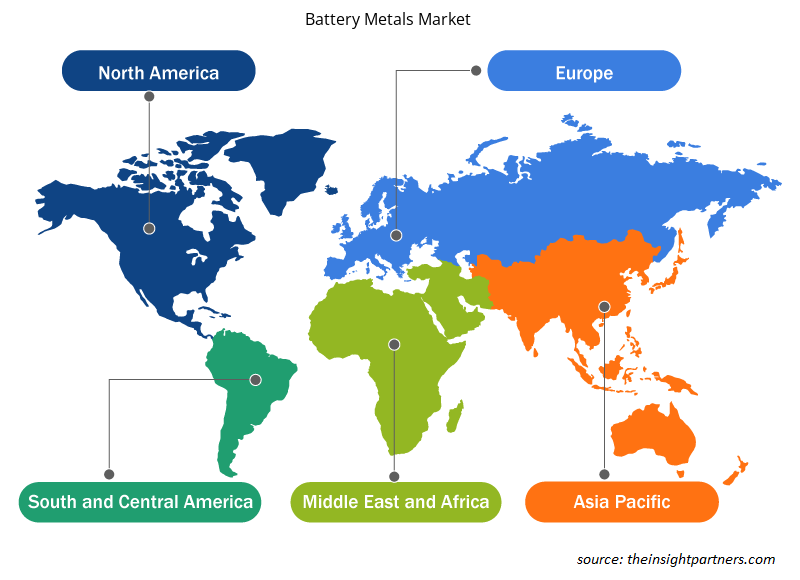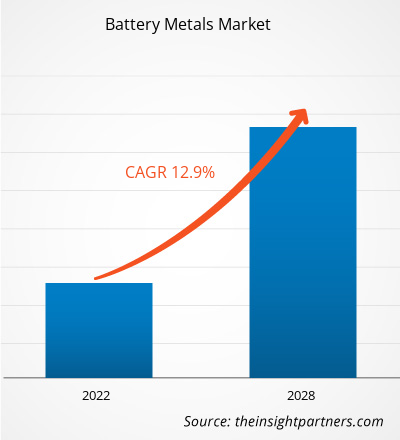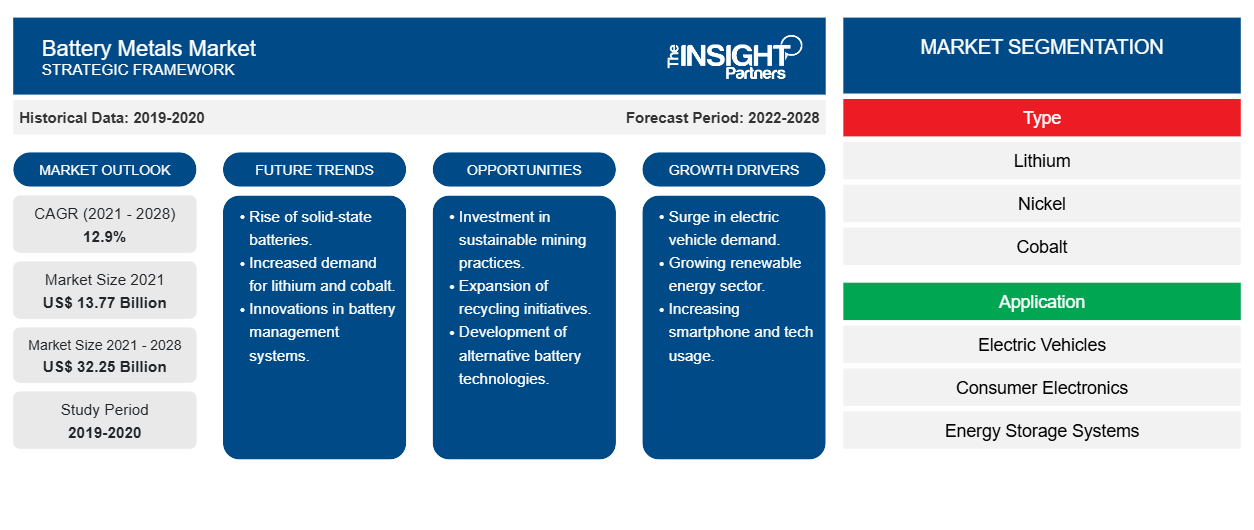[연구보고서] 배터리 금속 시장은 2021년 13,770.9백만 달러에서 2028년 32,251.1백만 달러로 성장할 것으로 전망되며, 2021년부터 2028년까지 연평균 성장률 12.9%로 성장할 것으로 예상됩니다.
리튬, 코발트, 니켈, 망간과 같은 배터리 금속은 배터리 제조의 원료로 사용됩니다. 이는 전기 자동차, 가전 제품 및 기타 응용 분야에서도 사용됩니다.
2020년 아시아 태평양 지역은 글로벌 배터리 금속 시장 에서 가장 큰 매출 점유율을 차지했습니다 . 다양한 아시아 태평양 국가는 자동차 및 전자 산업의 급증을 목격하고 있으며, 이는 예측 기간 동안 배터리 금속 시장 성장을 계속 촉진할 것으로 보입니다. 또한, APAC 전역의 전기 자동차 시장은 빠르게 확장되는 자동차 및 전자 부문으로 인해 눈에 띄는 성장을 목격했습니다.
귀하의 요구 사항에 맞게 이 보고서를 사용자 정의하세요
이 보고서의 일부 또는 국가 수준 분석, Excel 데이터 팩을 포함하여 모든 보고서에 대한 사용자 정의를 무료로 받을 수 있으며 신생 기업 및 대학을 위한 훌륭한 혜택과 할인 혜택을 이용할 수 있습니다.
-
이 보고서의 주요 시장 동향을 알아보세요.이 무료 샘플에는 시장 동향부터 추정 및 예측까지 다양한 데이터 분석이 포함됩니다.
COVID-19 팬데믹으로 인해 글로벌 공급망이 중단되었습니다. 광업, 화학 및 재료와 같은 많은 산업이 다양한 상품의 제조 및 배송 일정과 판매를 달성하는 데 있어 전례 없는 어려움에 직면했습니다. 그러나 경제가 운영을 되살리려는 계획에 따라 배터리 금속에 대한 수요는 전 세계적으로 증가할 것으로 예상됩니다. 자동차, 전자 및 기타 산업의 운영 재개로 인해 전 세계적으로 배터리 금속에 대한 수요가 증가했습니다. 소비자 전자 산업은 소비자 지출의 급증으로 역동적으로 확장되고 있습니다. 전기 자동차, 가전 제품 및 에너지 저장 시스템과 같은 다양한 응용 분야에서 배터리 금속에 대한 수요 증가와 저명한 제조업체의 상당한 투자는 향후 몇 년 동안 배터리 금속 시장 성장을 견인할 것으로 예상됩니다.
시장 통찰력
성장하는 전기 자동차 산업
전 세계적으로 전기 자동차에 대한 수요 급증은 배터리 금속 시장의 성장을 뒷받침합니다. 배터리 금속 기반 제품은 전기 자동차 산업 에서 차량을 운행하는 데 필요한 화석 기반 에너지를 대체하는 데 광범위하게 사용됩니다. 인구 밀도가 높은 지역에서는 전기 자동차가 널리 사용되어 차량 오염을 줄이는 데 사용되는데, 이러한 지역에서 사용되는 차량 수가 더 많기 때문입니다. 또한 에너지 다각화와 온실 가스 배출 감소를 위한 중요한 요소이기도 합니다. 전기 자동차의 이점에는 테일파이프 배출이 없고, 온실 가스 배출을 줄일 수 있는 잠재력이 있으며, 내연 기관 차량보다 효율성이 더 좋습니다.
중국, 인도, 미국을 포함한 많은 국가의 정부는 전기 자동차 채택을 장려하기 위한 규정을 통과시켰습니다. 전기 자동차와 그 시장은 2륜/3륜차, 버스, 트럭의 전기화에 대한 지속적인 기술 발전으로 인해 상당히 확대되고 있습니다.
국제 에너지 기구 보고서 '글로벌 EV 전망 2020'에 따르면, 2019년 전 세계 전기 승용차 재고는 지속적으로 확대되어 2018년보다 40% 증가한 720만 대에 달했습니다. 이러한 모든 요인으로 인해 전기 자동차/하이브리드 및 전기 자동차/플러그인 하이브리드 자동차에 대한 수요가 증가하고 있습니다. 이는 차례로 배터리 금속 시장을 상당히 주도하고 있습니다.
유형 기반 통찰력
배터리 금속 시장은 유형별로 리튬, 니켈, 코발트 및 기타로 세분화됩니다. 리튬 세그먼트는 2020년에 가장 큰 시장 점유율을 차지했습니다. 이 세그먼트의 성장은 가벼운 특성으로 인해 전기 자동차 및 전자 산업에서 리튬의 적용이 증가한 데 기인할 수 있습니다.
애플리케이션 기반 통찰력
배터리 금속 시장은 응용 분야에 따라 전기 자동차, 가전 제품, 에너지 저장 시스템 등으로 세분화됩니다. 배터리 금속 시장은 예측 기간 동안 가장 높은 CAGR을 보이는 전기 자동차 부문이 주도하고 있습니다. 선진국과 개발도상국의 다양한 정부 기관에서 규제 규범을 변경하여 무공해 차량에 대한 수요가 증가하면서 배터리 금속 시장에 큰 영향을 미치고 있습니다.
Albemarle Corporation; Umicore; LG Chem; Ganfeng Lithium Co., Ltd.; BASF SE; Bolt Metals Corp.; Honjo Metal Co., Ltd.; Lithium Australia NL; Vale; Metso Outotec은 배터리 금속 시장에서 활동하는 주요 기업 중 일부입니다. 이러한 시장 참여자는 고객 요구 사항을 충족하는 고품질의 혁신적인 제품을 개발하는 데 중점을 두고 있습니다. Albemarle Corporation은 노스캐롤라이나주 킹스 마운틴에 있는 자사 사이트에 Battery Materials Innovation Center(BMIC)를 출범했다고 발표했습니다. 이 연구소는 고급 리튬 금속 압연을 사용하여 20μm 두께(즉, 인간 머리카락의 평균 두께의 약 1/5) 또는 그보다 얇은 리튬 호일을 달성함으로써 배터리 에너지 밀도를 높이는 리튬 금속 애노드 기술을 생산했습니다. Ganfeng Lithium Industry의 자회사인 Jiangsu Ganfeng Power Technology Co., Ltd.는 공식적으로 새로운 공장으로 이전하고 장비 교체를 통해 생산 용량을 개선했습니다. 장쑤 간펑은 산업용 차량용 리튬 배터리 시스템을 주요 제품으로 제공하여 고객에게 장수명, 내구성, 유지 보수가 필요 없고 사용자 정의가 가능한 전원 시스템 솔루션을 제공하고 납산 배터리에서 철-리튬 배터리로 산업용 차량의 반복을 용이하게 합니다.
스포트라이트 보고서
- 글로벌 배터리 금속 시장의 진보적인 산업 동향은 플레이어가 효과적인 장기 전략을 개발하는 데 도움이 됩니다.
- 선진국과 개발도상국 시장에서 채택한 사업 성장 전략
- 2019년부터 2028년까지 글로벌 배터리 금속 시장의 정량적 분석
- 다양한 산업에 걸친 배터리 금속 수요 추산
- 경쟁 시장 상황과 전기 자동차 수요를 이해하기 위한 최근 동향
- 배터리 금속 시장 성장을 주도하고 제한하는 요인과 함께 결합된 시장 동향 및 전망
- 글로벌 배터리 금속 시장 성장과 관련하여 상업적 이익을 뒷받침하는 전략을 이해하여 의사 결정 프로세스
- 시장의 다양한 노드에서의 배터리 금속 시장 규모
- 글로벌 배터리 금속 시장과 산업 내 역학에 대한 자세한 개요 및 세분화
- 유망한 성장 기회를 갖춘 다양한 지역의 배터리 금속 시장 규모
배터리 금속 시장 지역 통찰력
Insight Partners의 분석가들은 예측 기간 동안 배터리 금속 시장에 영향을 미치는 지역적 추세와 요인을 철저히 설명했습니다. 이 섹션에서는 북미, 유럽, 아시아 태평양, 중동 및 아프리카, 남미 및 중미의 배터리 금속 시장 세그먼트와 지리에 대해서도 설명합니다.

- 배터리 금속 시장에 대한 지역별 특정 데이터 얻기
배터리 금속 시장 보고서 범위
| 보고서 속성 | 세부 |
|---|---|
| 2021년 시장 규모 | 137억 7천만 달러 |
| 2028년까지 시장 규모 | 322억 5천만 달러 |
| 글로벌 CAGR (2021-2028) | 12.9% |
| 역사적 데이터 | 2019-2020 |
| 예측 기간 | 2022-2028 |
| 다루는 세그먼트 |
유형별로
|
| 포함된 지역 및 국가 |
북아메리카
|
| 시장 선도 기업 및 주요 회사 프로필 |
|
시장 참여자 밀도: 비즈니스 역학에 미치는 영향 이해
배터리 금속 시장 시장은 소비자 선호도의 변화, 기술 발전, 제품의 이점에 대한 인식 증가와 같은 요인으로 인해 최종 사용자 수요가 증가함에 따라 빠르게 성장하고 있습니다. 수요가 증가함에 따라 기업은 제품을 확장하고, 소비자의 요구를 충족하기 위해 혁신하고, 새로운 트렌드를 활용하여 시장 성장을 더욱 촉진하고 있습니다.
시장 참여자 밀도는 특정 시장이나 산업 내에서 운영되는 회사나 기업의 분포를 말합니다. 주어진 시장 공간에 얼마나 많은 경쟁자(시장 참여자)가 존재하는지 그 규모나 전체 시장 가치에 비해 나타냅니다.
배터리 금속 시장에서 운영되는 주요 회사는 다음과 같습니다.
- 알베마를 코퍼레이션
- 볼트 메탈
- 감풍리튬(주)
- 유미코어
- 엘지화학
면책 조항 : 위에 나열된 회사는 어떤 특별한 순서에 따라 순위가 매겨지지 않았습니다.

- 배터리 금속 시장 주요 주요 업체 개요를 알아보세요
배터리 금속 시장, 유형별
- 리튬
- 니켈
- 코발트
- 기타
배터리 금속 시장, 응용 분야별
- 전기 자동차
- 가전제품
- 에너지 저장 시스템
- 기타
회사 프로필
- 알베마를 코퍼레이션
- 유미코어
- 엘지화학
- 감풍리튬(주)
- 바스프 SE
- 볼트 메탈스 코퍼레이션
- 혼조금속 주식회사
- 리튬 호주 NL
- 골짜기
- 메초 아우토텍
- 미국 요소
- 과거 분석(2년), 기준 연도, CAGR을 포함한 예측(7년)
- PEST 및 SWOT 분석
- 시장 규모 가치/거래량 - 글로벌, 지역, 국가
- 산업 및 경쟁 환경
- Excel 데이터세트
최근 보고서
관련 보고서
사용 후기
구매 이유
- 정보에 기반한 의사 결정
- 시장 역학 이해
- 경쟁 분석
- 고객 인사이트
- 시장 예측
- 위험 완화
- 전략 기획
- 투자 타당성 분석
- 신흥 시장 파악
- 마케팅 전략 강화
- 운영 효율성 향상
- 규제 동향에 발맞춰 대응























 무료 샘플 받기 - 배터리 금속 시장
무료 샘플 받기 - 배터리 금속 시장